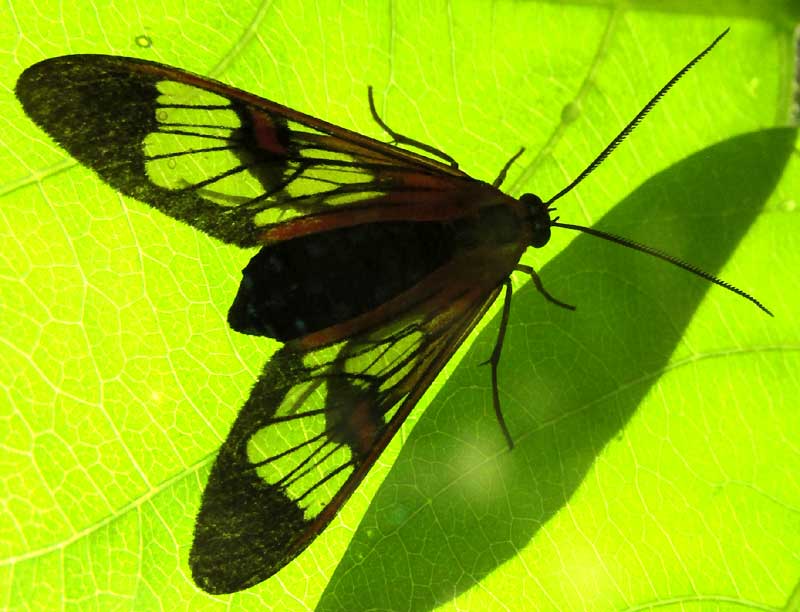Excerpts from Jim Conrad's
Naturalist Newsletter

from the November 1, 2015 Newsletter issued from Hacienda Chichen Resort beside Chichén Itzá Ruins, central Yucatán, MÉXICO
RED-SPOT WASP MIMIC MOTH
A winged critter flitted across the forest trail about a foot off the ground, taking refuge at the trail's edge on the undersurface of a leaf about ankle high. Lying on my back peeping beneath the leaf, I could see that this was something new. Above you can see it with sunlight brilliantly illuminating its leaf from the top side.
With such transparent windows in the wings, at first I thought it was a kind of picturewing fly, but flies aren't supposed to have such long, slender antennae, especially not antennae with comb-tooth-like appendages along their lengths, as this insect has. This must be a moth masquerading as a fly or fly-like dipterid. Off the picture went to volunteer moth specialist Bea in Ontario.
It didn't take Bea long to figure out that we did indeed have a moth, a member of the tiger moth genus Cosmosoma. Moreover, she said it looked a lot like COSMOSOMA TEUTHRAS, distributed from central Mexico south through Central America to Brazil. A page on moths of the Andes provides an English name of Red-spot Wasp Mimic, and it's true that the moth's particular reddish-orange color is similar to that of certain wasp species, which also bear mostly transparent wings, so we'll go with that name.
Happily, on the Internet, Mexico's University of Veracruz freely offers a download of a paper, a monograph, by Vianney Rodríguez Hernández, dealing with the Mexican distribution of a certain subgroup of moths, to which our Red-spot Wasp Mimic belongs. That treatment suggests that in the Yucatan we can look for three species of the genus Cosmosoma, and of those three the most common and the one looking most like ours is Cosmosoma teuthras.
Little is published about Cosmosoma teuthras, though I read that the caterpillars of another Cosmosoma species feed on certain vining members of the Dog Bane Family. That family is famed for producing white latex filled with powerful and often toxic chemicals, often resulting in the caterpillars who eat them being protected from predators not eager to ingest the caterpillars' toxic chemicals. Monarch Butterfly caterpillars feed on milkweeds, which are members of the Dog Bane Family.
During feeding, the collection of chemicals for non-nutritive purposes is termed pharmacophagy, and Cosmosoma species appear to be pharmacologic. It's unclear whether the toxins' protective effects extends to adults of the species. Adults can be found foraging among various types of blossoms.